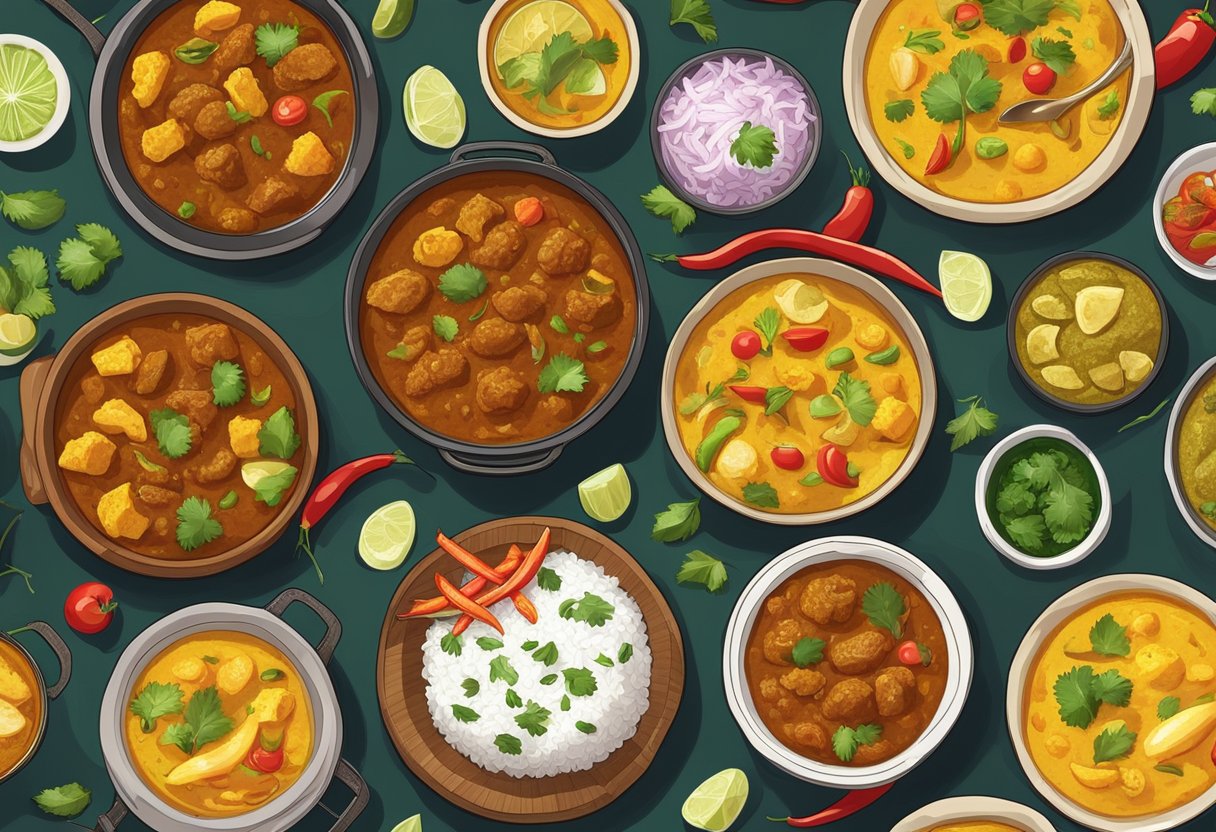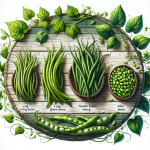Types Of Curry
Curry is a popular dish that originated in India and has spread to many parts of the world. It is a flavorful and aromatic dish that is made with a combination of spices, herbs, and other ingredients. There are many different types of curry, each with its unique flavor, aroma, and texture.

Curry is a staple in Indian cuisine and is enjoyed by people all over the world. It is a versatile dish that can be made with a variety of ingredients, including meat, vegetables, and seafood. Thai curry is another popular type of curry that is known for its spicy and aromatic flavor. Japanese curry is another variation that is milder in flavor and often served with rice.
Key Takeaways
- Curry is a popular dish that originated in India and has spread to many parts of the world.
- There are many different types of curry, each with its unique flavor, aroma, and texture.
- Curry is a versatile dish that can be made with a variety of ingredients, including meat, vegetables, and seafood.
Historical Origins of Curry
Curry is a dish that has been enjoyed by people around the world for centuries. Its history can be traced back to India, where it originated as a way to add flavor to meat and vegetable dishes. Over time, different regions developed their own unique styles of curry, each with its own blend of spices and ingredients.
Indian Curry Origins
The origins of Indian curry can be traced back to ancient times when people in the region began using a variety of spices to flavor their food. The use of turmeric, cumin, coriander, and other spices can be found in Indian cuisine dating back thousands of years. The word “curry” itself is believed to have come from the Tamil word “kari,” which means sauce or gravy.
Indian curries can vary greatly in terms of flavor and heat level, depending on the region and the cook. Some of the most popular types of Indian curry include butter chicken, tikka masala, and vindaloo.
Thai Curry Influences
Thai curries are another popular type of curry that has its own unique flavor profile. Thai curries are typically made with a base of coconut milk and are flavored with a variety of spices and herbs, including lemongrass, galangal, and kaffir lime leaves.
Thai curries were heavily influenced by Indian curries, which were introduced to Thailand by Indian traders several centuries ago. Over time, Thai cooks developed their own unique style of curry, which is now enjoyed around the world.
Spread to Southeast Asia and Japan
Curry eventually made its way to Southeast Asia, where it became a popular dish in countries such as Indonesia, Malaysia, and Singapore. In these regions, curry is often made with a variety of local ingredients, such as fish sauce and palm sugar.
In Japan, curry was introduced in the late 1800s by the British, who had developed a taste for Indian curry during their time in India. Japanese curry is typically made with a roux, which gives it a thick, gravy-like consistency. It is often served with rice and is a popular comfort food in Japan.
Overall, curry is a dish that has a rich and diverse history, with each region adding its own unique twist to the dish. Whether you prefer Indian curry, Thai curry, or Japanese curry, there is no denying the deliciousness of this beloved dish.
Primary Ingredients and Spices
Curry is a versatile dish that can be made with a variety of ingredients and spices. The following are some of the most common ingredients and spices used in curry dishes.
Common Curry Spices
Curry powder typically includes a blend of spices such as turmeric, cumin, coriander, ginger, and chili powder. These spices give curry its distinctive flavor and aroma. Other spices that may be used in curry include garlic, galangal, and lemongrass.
Meat and Vegetarian Options
Curry can be made with a variety of meats such as chicken, beef, lamb, or fish. Vegetarian options include tofu, chickpeas, or lentils. The choice of protein can greatly affect the flavor and texture of the dish.
Additional Flavor Enhancers
Coconut milk is a popular ingredient in many curry dishes, adding creaminess and sweetness to the dish. Tamarind is another common ingredient used to add a sour and tangy flavor to the dish. Chilies are often used to add heat to the dish, while fresh herbs such as cilantro or basil can add freshness and brightness.
When cooking curry, it’s important to balance the flavors of the spices and ingredients. Too much of one spice can overpower the dish, while too little can make it bland. With the right combination of spices and ingredients, curry can be a flavorful and satisfying meal.
Regional Curry Variations
Indian Regional Curries
India is a land of diverse cultures and cuisines, and this is reflected in the variety of curries found in different regions of the country. Some of the most popular Indian curries include Vindaloo, Tikka Masala, Korma, Madras, and Rogan Josh.
Vindaloo is a spicy curry that originated in the coastal state of Goa. It is made with a blend of spices, vinegar, and fiery red chilies. Tikka Masala, on the other hand, is a creamy and mildly spiced curry that is said to have originated in the UK. It is made with marinated chicken pieces that are grilled and then simmered in a tomato-based sauce.
Korma is a mild and creamy curry that is popular in Northern India. It is made with yogurt, cream, and a blend of aromatic spices. Madras is a spicy curry that originated in the Southern Indian city of Madras (now Chennai). It is made with a blend of spices and chili powder.
Rogan Josh is a rich and aromatic curry that is popular in the Northern Indian state of Kashmir. It is made with lamb or goat meat, and a blend of spices that includes fennel, ginger, and cinnamon.
Thai Curry Types
Thai curries are known for their vibrant colors and bold flavors. Some of the most popular Thai curries include Green Curry, Red Curry, and Yellow Curry.
Green Curry is a spicy and aromatic curry that is made with green chilies, lemongrass, and coconut milk. It is popular in Central Thailand. Red Curry is another spicy curry that is made with red chilies, garlic, and shallots. It is popular in Northern Thailand.
Yellow Curry is a milder curry that is made with turmeric, cumin, and coriander. It is popular in Southern Thailand. Other popular Thai curries include Panang Curry, Massaman Curry, and Jungle Curry.
Unique Curries Around the World
Curries are not limited to India and Thailand. There are many unique curries found around the world. For example, Japanese Curry is a mild and sweet curry that is made with a blend of spices and apples. It is often served with rice and breaded pork or chicken.
Butter Chicken is a popular curry in India that is made with marinated chicken that is cooked in a tomato-based sauce that is rich in butter and cream. It is often served with naan bread or rice.
In conclusion, curries come in many different varieties and flavors. Whether you prefer spicy or mild, creamy or tangy, there is a curry out there for everyone.
Cooking Techniques and Styles
Preparing the Base Sauce
The base sauce is a crucial component of any curry dish. It is what gives the curry its distinct flavor and texture. The base sauce can be made using a variety of ingredients, including cream, coconut cream, curry paste, curry powder, and garam masala.
To prepare the base sauce, one can use either a wet or dry cooking method. Wet cooking involves cooking the ingredients in the sauce, while dry cooking involves roasting or toasting the ingredients before adding them to the sauce.
When using a wet cooking method, it is important to ensure that the sauce is cooked for a sufficient amount of time to allow the flavors to meld together. This can take anywhere from 30 minutes to several hours, depending on the type of curry and the desired level of flavor.
Dry and Wet Cooking Methods
Dry cooking methods, such as roasting or toasting, are often used to bring out the flavors of certain spices and ingredients. This method is commonly used in dishes such as tandoori chicken and biryani.
Wet cooking methods are used to create a sauce or gravy that coats the ingredients and infuses them with flavor. This method is commonly used in dishes such as naan and wet curries.
Overall, the cooking techniques and styles used in curry dishes are diverse and varied. From wet curries to dry roasts, there is no shortage of ways to prepare and enjoy curry.
Serving and Pairing
Accompaniments and Side Dishes
Curry is a versatile dish that can be paired with a wide range of accompaniments and side dishes. One of the most popular choices is rice, which can be served plain or flavored with spices and herbs. Naan bread, a type of Indian flatbread, is also a popular choice. It is soft and chewy and can be used to scoop up the curry or to soak up the sauce.
Chutneys and pickles are another great accompaniment to curry. They add a tangy, spicy flavor to the dish and can be used to balance out the heat of the curry. Mint chutney, tamarind chutney, and mango pickle are some of the most popular choices.
Wine and Beverage Pairings
When it comes to pairing wine with curry, it is important to choose a wine that can stand up to the bold flavors and spices of the dish. A full-bodied red wine like a Shiraz or Malbec can be a good choice, as can a spicy white like a Gewürztraminer or Riesling. Beer is also a popular choice, with a hoppy IPA or a crisp lager being a good match for the bold flavors of curry.
When dining at an Indian restaurant, it is common to pair curry with a cold, refreshing beverage like a lassi or a mango juice. These drinks can be used to cool down the heat of the curry and refresh the palate between bites.
In conclusion, curry is a versatile dish that can be paired with a wide range of accompaniments and beverages. Whether you prefer rice, naan, chutneys, or pickles, there is an option that can complement the flavors of the dish. When it comes to wine and beverage pairings, it is important to choose a drink that can stand up to the bold flavors of the curry and provide a refreshing contrast to the heat of the dish.






